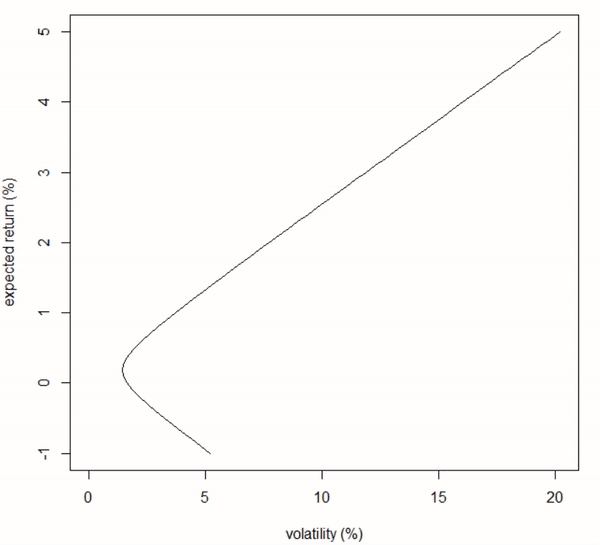Incremental efficient frontier
In this tutorial, I quickly describe how to compute and update an efficient frontier in adding stocks to an existing porfolio with R.
Step 1: Efficient frontier
First let’s write a simple code for an efficient frontier computation
Code
efficient_frontier = function(MRet #matrix of returns (MRet)
, rangeMu) #range (sequence) of target expected returns (rangeMu)
{
uM <- dim(MRet)[1] #get the row (uM) and column (pM) dimensions of the matrix of returns
pM <- dim(MRet)[2]
expRet <- colMeans(MRet) #compute the portfolio's individual stocks expected returns
Omega = var(MRet) #compute the sample var-covar matrix
unityVec <- rep(1, pM) #define a constraints vector (weights of the portfolio must sum to one)
A <- rbind(expRet, unityVec) #define a matrix of constraints (weights sum to one and variance will match a #target level of expected returns)
n <- length(rangeMu) #get the length of the target range (sequence)
myVar <- rep(NA, n) #define an empty variance vector
myWeights <- matrix(data = NA, nrow = n, ncol = pM) #define an empty matrix of weights for each stock at each level of target
#expected returns
for(i in 1:n) #loop over the target expected returns range and compute variances and weights
{
b <- matrix(data = c(rangeMu[i], 1), nrow = 2)
myVar[i] <- t(b) %*% solve(A %*% solve(Omega) %*% t(A)) %*% b
myWeights[i,] <- solve(Omega) %*% t(A) %*% solve(A %*% solve(Omega) %*% t(A)) %*% b
}
mySd <- myVar^0.5 #compute the standard deviation vector
return(mySd) #return the standard deviation vector
}Step 2: Incremental efficient frontier
Code
efficient_frontier_increment = function(MRet) #define a function that takes as argument a matrix of returns (MRet)
{
pM <- dim(MRet)[2] #get the column (pM) dimension of the matrix of returns
rangeMu <- seq(-0.01, 0.05, 0.001) #hard code the vector of expected returns (can be passed as argument)
mySd <- efficient_frontier(MRet[, 1:9], rangeMu) #compute the sd vector of the portfolio composed of the first nine stocks
dev.new() #get a new plot
plot(mySd * 100 #plot the efficient frontier of the portfolio composed of the first 9 stocks
, rangeMu * 100
, xlab = "volatility (%)"
, ylab = "expected return (%)"
, t = 'l'
, xlim = c(0, max(mySd * 100))
, ylim = c(-1, 5))
Sys.sleep(2) #enjoy the chart for two seconds
for(j in 10:pM) #loop over all stocks and increment the portfolio with the next stock
{
mySd <- efficient_frontier(MRet[, 1:j], rangeMu) #recompute the efficient frontier
lines(mySd * 100, rangeMu * 100, col = 'red') #add a line of the more efficient frontier on the chart
Sys.sleep(0.1) #define how long you want to wait before the next one
}
}Result in animation

Fig 1. Animation of an efficient frontier with stock increment
To run the code with real historical figures, I propose a *.csv file of NYSE returns Download nyse_stocks_historical_returns.csv